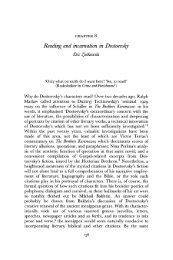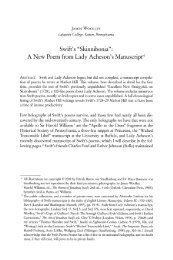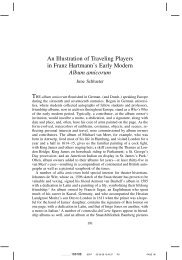courses of instruction - Lafayette College
courses of instruction - Lafayette College
courses of instruction - Lafayette College
You also want an ePaper? Increase the reach of your titles
YUMPU automatically turns print PDFs into web optimized ePapers that Google loves.
LAFAYETTE COLLEGE<br />
Revolution as "a testimony <strong>of</strong> respect for<br />
(his) talents, virtues, and signal services ..<br />
.. the great cause <strong>of</strong> freedom."<br />
The governor <strong>of</strong> Pennsylvania signed<br />
the new college's charter on March 9,<br />
1826, but getting the charter proved to<br />
be considerably easier than launching the<br />
<strong>College</strong>. In 1832, the Rev. George Junkin,<br />
a Presbyterian minister, agreed to move<br />
the curriculum and student body <strong>of</strong> the<br />
Manual Labor Academy <strong>of</strong> Pennsylvania<br />
from Germantown to Easton and to take<br />
up the <strong>Lafayette</strong> <strong>College</strong> charter. On May<br />
9,1832, classes in mathematics and the<br />
classics began in a rented farmhouse on<br />
the south bank <strong>of</strong> the Lehigh River, where<br />
the 43 students labored in the fields and<br />
workshops to earn money in support <strong>of</strong><br />
the educational program.<br />
In their original petition the planners<br />
<strong>of</strong> the <strong>College</strong> had cited mathematics as<br />
an example <strong>of</strong> their educational philoso<br />
phy. "Such branches will be selected and<br />
so pursued, as will not only discipline<br />
the mind, and induce habits <strong>of</strong> patient<br />
investigation, but also directly subserve<br />
the purposes <strong>of</strong> life." That sound princi<br />
ple animated much <strong>of</strong> the subsequent<br />
curricular development at <strong>Lafayette</strong> as,<br />
indeed, it does today.<br />
The founders noted in 1824 that "the<br />
language most neglected in our seminar<br />
ies <strong>of</strong> learning is the English." In 1857<br />
<strong>Lafayette</strong> became the first American<br />
college to establish a chair for the study<br />
<strong>of</strong> the English language and literature,<br />
with emphasis on philology. Francis A.<br />
March, its first incumbent, achieved inter<br />
national fame for his work in establishing<br />
English as a pivotal subject in the liberal<br />
arts curriculum.<br />
Similarly, the founders complained<br />
that "civil engineering has <strong>of</strong> late become<br />
a very prominent branch <strong>of</strong> education,<br />
and what is remarkable, not a <strong>College</strong> in<br />
our country (if we are correctly informed)<br />
has made it a part <strong>of</strong> their course." In<br />
1866 <strong>Lafayette</strong> secured funds from Ario<br />
Pardee, a mining magnate and industrial<br />
ist, to establish a new course in science<br />
and engineering, one <strong>of</strong> the first in any<br />
liberal arts college. The resulting union<br />
<strong>of</strong> arts, sciences, and engineering remains<br />
perhaps the most unusual feature <strong>of</strong> the<br />
<strong>Lafayette</strong> curriculum.<br />
In 1832 the <strong>College</strong> acquired nine acres<br />
<strong>of</strong> land on an eminence across Bushkill<br />
Creek from Easton. Formally named "Mt.<br />
<strong>Lafayette</strong>," the elevation soon became<br />
more familiarly known as "<strong>College</strong> Hill."<br />
On its summit in 1834 rose the first <strong>of</strong> the<br />
<strong>College</strong>'s own buildings, on a site now<br />
incorporated into South <strong>College</strong>. Today<br />
the campus comprises about 100 acres <strong>of</strong><br />
land and more than 50 buildings, as well<br />
as various outlying properties and struc<br />
tures on <strong>College</strong> Hill and elsewhere.<br />
Like the physical plant, enrollment<br />
grew steadily. By the turn <strong>of</strong> the century<br />
it stood at about 300, passed the 500 mark<br />
in 1910, and reached 1,000 during the<br />
1920s. It more than doubled again as<br />
returning veterans swamped the <strong>College</strong><br />
after World War II. As the GI tide ebbed,<br />
the enrollment dropped back to about<br />
1,500 men.<br />
Addition <strong>of</strong> women to the student<br />
population they now make up about<br />
48 percent <strong>of</strong> the student body raised<br />
the total enrollment to about 2,100, where<br />
it remains today. Enrollment as <strong>of</strong> August<br />
31,1998, was 2,103.<br />
LAFAYETTE TODAY<br />
<strong>Lafayette</strong> <strong>College</strong> <strong>of</strong>fers only undergrad<br />
uate programs. It grants the Bachelor <strong>of</strong><br />
Arts degree in 25 established major<br />
fields, the Bachelor <strong>of</strong> Science in nine<br />
fields <strong>of</strong> science and four <strong>of</strong> engineering.<br />
Interdisciplinary majors have been estab<br />
lished in American Studies, Behavioral<br />
Neuroscience, Biochemistry, International<br />
Affairs, Mathematics and Economics,<br />
and Russian and East European Studies;<br />
in addition, a number <strong>of</strong> departments<br />
have joined others in <strong>of</strong>fering coordinate<br />
majors. Many departments also permit a<br />
minor in the field. A five-year, two-degree<br />
plan is also available. Descriptions <strong>of</strong> major<br />
programs and requirements may be found<br />
on pp. 37-177.<br />
The governing body <strong>of</strong> the <strong>College</strong> is<br />
the Board <strong>of</strong> Trustees, which holds title<br />
to the <strong>College</strong>'s properties, manages and<br />
allocates its funds, determines the broad<br />
policies under which programs are <strong>of</strong>fered,











